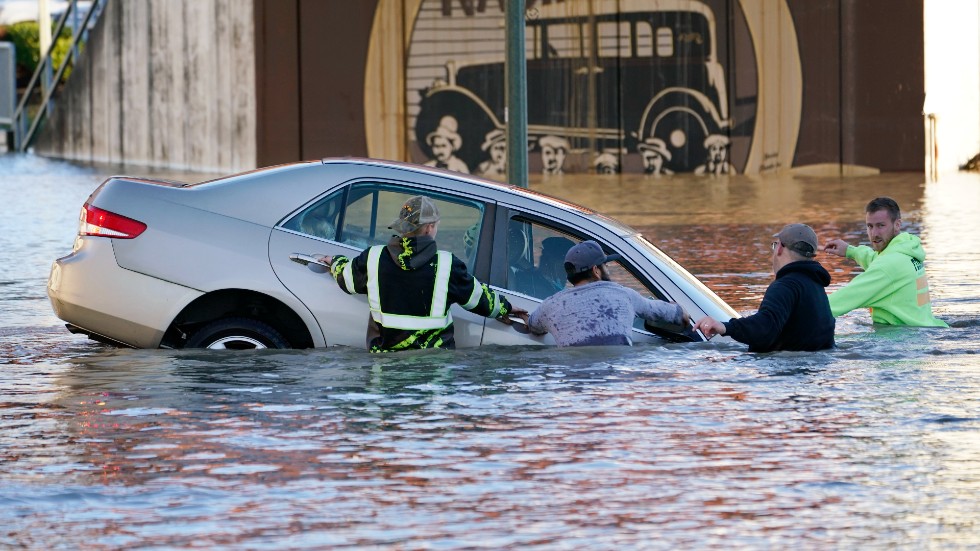Equilibrium/Sustainability — Presented by Southern Company — Native solar startups see business as activism

Today is Wednesday. Welcome to Equilibrium, a newsletter that tracks the growing global battle over the future of sustainability. Subscribe here: digital-release.thehill.com/newsletter-signup.
Amid a series of battles between Native American activists and oil pipeline companies, Ojibwe activist and entrepreneur Robert Blake saw a clear solution: distributed solar power, Grist reported.
The Department of Energy just awarded a $6.6 million grant to Native Sun Community Power Development of Minneapolis — where Blake is executive director — and the Standing Rock Renewable Energy Power authority, which runs the largest solar farm in North Dakota, according to Grist.
The money is intended to fund electric vehicles and charging stations, building on ongoing work — catalyzed by the 2016 protests at Standing Rock against the Dakota Access Pipeline — to build Native-run renewable energy generation.
“Whether we’re building the electric vehicle charging network, solar farms, energy efficient projects, whatever it is, native people are going to try to reduce their reliance on fossil fuels…because we know that that’s what’s killing our mother,” Blake told Grist. “We know that’s killing the planet.”
Today, we’re examining what has been called the biggest oil and gas lease sale in United States history — and why the Biden administration said it had no choice but to carry it out. Then we’ll consider a small piece of the bipartisan infrastructure plan, which could make religious institutions into model sites for energy efficiency.
For Equilibrium, we are Saul Elbein and Sharon Udasin. Please send tips or comments to Saul at selbein@digital-release.thehill.com or Sharon at sudasin@digital-release.thehill.com. Follow us on Twitter: @saul_elbein and @sharonudasin.
Let’s get to it.
Gulf oil, gas leases sold days after COP26

The Biden administration offered up 80 million acres of the Gulf of Mexico for oil and gas drilling on Wednesday, going back on a campaign promise to end new fossil fuel developments on federal lands and waters, The Hill reported.
The sale of oil and gas leases, for which 33 companies offered bids on 1.7 million acres of seafloor, comes less than a week after the COP26 climate conference, where President Biden promised to “lead by example” in combating global warming, The Guardian reported.
It also relies on a counterintuitive idea from the Trump administration: that not selling the leases will lead to higher emissions than selling them.
First words: In the face of anger from civil society groups, White House press secretary Jen Psaki said the government was “required” to proceed with the sale.
“But it’s important for advocates and other people out there to understand that it’s not aligned with our view, the President’s policies or the executive order that he signed,” Psaki said, according to CNN.
Then why did they do it? Bear with us. In January, Biden signed an executive order pausing all new oil and gas leases on federal land to give the administration time to evaluate whether it fit “our nation’s climate, conservation, and clean energy goals.”
Thirteen Republican-led oil states sued, and in June a federal judge in Louisiana ruled that the lease sales must continue while that suit worked its way through the courts, The Hill reported.
Back from the dead: That meant the revival of one particular lease sale: number 257, which had originally been proposed and prepared for by the Trump Administration and scheduled the bidding process for March 2021.
That lease was based on dubious logic, advocates say: Namely, that emissions would be higher if the sale didn’t go ahead, because more polluting foreign oil would fill the gap, as PBS laid out.
But that doesn’t factor in how increased production of U.S. oil changes the whole global market, raising consumption — and emissions — around the world, a study from the Stockholm Environmental Institute has found.
“The math is extremely simple on this kind of stuff:” more oil supply, more oil emissions, study author Peter Erickson told PBS.
The DOI agrees — in theory: The Department of the Interior has adopted Erickson’s conclusions in ongoing evaluations over whether to allow drilling in the Cook Inlet of Alaska, attorney Brettny Hardy of Earthjustice told Equilibrium.
“They found that without a lease sale in the Cook inlet, carbon dioxide emissions decrease by 31 million tons,” she said.
A MESSAGE FROM SOUTHERN COMPANY
At Southern Company, we achieved our interim net zero energy goal ten years early. Today, we continue our work toward a net zero future. Learn more.
SO WHY DID THIS LEASE GO AHEAD?
Too far gone: Lease Sale 257 was too far along to apply the new methods, officials told PBS. The sale was brokered by an administration that has approved more than 300 new drilling permits per day — “a faster pace even than under … Trump,” The Guardian reported.
The leases would account for 300 million tons of carbon dioxide emissions over the next 40 years — about what the UK releases each year, according to The Guardian.
Was there another choice for DOI? Yes. The Louisiana decision “doesn’t force the administration to move forward with any particular lease sale,” Max Sarinsky of the New York University School of Law told The Guardian, though he added that if the sale were postponed, “I’m almost certain they would be sued by oil and gas interests.”
Hardy of Earthjustice — which is leading a lawsuit against the DOI by several civil society groups attempting to stop the sale — argued that the DOI has essentially passed the buck.
The Outer Continental Shelf Lands Act “gives the DOI broad discretion to cancel lease sales,” she said, which was entirely separate from the January executive order.
Last words: “So despite the order from Louisiana, the DOI could have gone back and said, ‘Actually, we’re [blocking the sale] because of climate impacts – not the Biden administration pause,’” Hardy said.
“This does not deliver on the climate promises that Biden made even just last week at COP26 to overhaul fossil fuel programs and end new leasing and stop digging the hole we’re in,” she added.
Making religious institutions more sustainable
A $50 million slice of the $1.2 trillion bipartisan infrastructure bill will go toward making nonprofits and religious institutions more energy efficient, but community leaders think that this program could have economic and environmental impacts far beyond that limited sum.
“Having a green project can spur other developments in the community, and a church or synagogue is well placed to have that bully pulpit and expand the roots of what’s a relatively modest $50 million program at this point,” Stephan Kline, associate vice president for public policy at the Jewish Federations of North America (JFNA) told Equilibrium.
First steps: The $50 million in question — folded into the infrastructure bill from Sen. Amy Klobuchar’s (D-Minn.) Nonprofit Energy Efficiency Act — will enable nonprofit groups to apply for grants of up to $200,000 to make their buildings more energy efficient. That grant money would go toward upgrading existing infrastructure, like HVAC systems, lights, doors and windows.
The secretary of Energy has one year from the date of enactment to establish the grant rewards program, according to the bill. To be eligible, applicants will need to demonstrate the energy savings that would be achieved, the cost effectiveness of using energy-efficient materials and financial need.
Is renewable energy generation included? That’s uncertain. The initial text of Klobuchar’s bill included a provision for renewables, but it has yet to be determined whether such installations will be permissible, according to a source familiar with the legislation.
The infrastructure bill text states that upgrades must involve “energy-efficiency material” — or a material whose installation “results in a reduction in use by a nonprofit organization of energy or fuel,” and neither includes nor excludes renewable systems.
“Good stewards of the environment”: Nathan Diament, executive director of the Orthodox Union Advocacy Center — the public policy arm of the Orthodox Jewish organization — was responsible for the first draft of the Nonprofit Energy Efficiency Act, which he drafted 10 years ago, before contacting Klobuchar and Sen. John Hoeven (R-N.D.).
In addition to the JFNA and the OU Advocacy Center, the coalition supporting the legislation’s passage grew to include a long list of faith-based groups around the country.
“We’ve all become more and more aware of the need to conserve energy and have buildings operate more efficiently to be good stewards of the environment,” Diament told Equilibrium.
But until recently, it was hard to act on it: Collectively, nonprofits spend billions each year on energy costs — typically about 5-7 percent of their annual budgets, according to the JFNA. But because energy efficiency incentives are usually structured as tax credits and rebates, tax-exempt nonprofits are not able to take advantage of them, a statement from the JFNA said.
‘A WIN-WIN FOR THE ENVIRONMENT AND FOR THE MISSION’
Serving as models: Faith-based groups are uniquely equipped to model behaviors to their congregants like increasing energy efficiency because their communities are inherently built on a certain set of values, Diament said.
“That modeling is very powerful and we do think will influence people to think about these issues in their homes and in their businesses,” he added.
“Our common home”: For the Catholic community, the nonprofit energy provision speaks to Pope Francis’s call “to live out in harmony with the created order, with creation — our common home,” Anthony Granado, vice president of government relations at Catholic Charities, told Equilibrium.
The policy, Granado added, will help Catholic charities and churches “live that out in a very tangible way,” while helping both reduce energy consumption and energy costs.
For similar reasons, YMCA of the USA will also be encouraging Y facilities to apply for the grants, according to Kelly Kennai, senior director for communications and advocacy engagement for the organization.
Last words: Since Ys primarily serve communities by way of their physical facilities, “being energy efficient in our buildings really is both environmentally critical and fiscally important,” Kennai said. “It’s really a win-win for the environment and for the mission.”
A MESSAGE FROM SOUTHERN COMPANY
At Southern Company, we achieved our interim net zero energy goal ten years early. Today, we continue our work toward a net zero future. Learn more.
Watery Wednesdays

Water issues three ways: in lethal storms, in diminishing municipal supplies and as the home of lobsters and whales.
First fatality reported in Pacific Northwest storms
- The huge storm that hit the Pacific Northwest earlier this week has left at least one fatality: a woman killed in a landslide in British Columbia — with more expected, according to The Guardian.
- “Investigators have received two missing people reports and believe there may have been other occupied vehicles that were lost in the slide,” Sergeant Janelle Shoihet of the Royal Canadian Mounted Police told reporters.
- Search crews and the military continue to search for survivors with “heavy equipment and dog teams,” The Guardian reported.
Californians are ‘backsliding’ on water conservation efforts
- Despite the ongoing drought plaguing California, statewide water use in September decreased only 3.9 percent in comparison to the same month a year ago — and was also a smaller reduction than in August, when Californians consumed 5 percent less than the year before, according to the Los Angeles Times.
- While Gov. Gavin Newsom called on Californians in July to cut water use by 15 percent, he issued a statewide emergency last month, after the voluntary reduction request proved to be insufficient, as we reported.
- “The backsliding isn’t welcome,” Joaquin Esquivel, chair of the State Water Resources Control Board, told the Times. “We need to continue to focus on conserving in this critical time during drought.”
Court reinstates lobster fishing ban, in effort to save whales
- A federal appeals court is prohibiting lobster fishing in a large portion of the Gulf of Maine, in a win for environmental groups who were seeking to protect the endangered right whale from getting caught in fishing gear, The Hill reported.
- The decision will bar the use of traps — which can entangle the whales and prevent them from feeding — in a roughly 950-square-mile area of the gulf from October to January.
- The North Atlantic right whale is among the most endangered species in the world, with fewer than 400 remaining, according to the National Oceanic and Atmospheric Administration.
Please visit The Hill’s sustainability section online for the web version of this newsletter and more stories. We’ll see you on Thursday.
{mosads}
Copyright 2023 Nexstar Media Inc. All rights reserved. This material may not be published, broadcast, rewritten, or redistributed.



